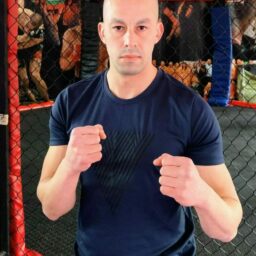In the ’70s and ’80s, Karate was one of the leading martial arts for self-defense. This has long since changed, but Karate, in its many styles, remains very popular and widely practiced. But many other systems offer better real-life effectiveness, and the one with them is Krav Maga. So how do the two compare?
Karate is a Japanese martial art trained as a complete character development system, a combat sport, and a method of self-defense. Krav Maga is a fighting system laser-focused on real-world effectiveness and teaching its students how to defend themselves. Depending on the training a Krav Maga school is doing, the style can vary from great for self-defense to completely useless, while Karate, for the most part, is adequate.
Most people practice martial arts for more than fighting skills, so let’s see what Krav Maga and Karate can offer in all aspects, making your choice clearer by the end of the article.
What Is Karate
Karate is a Japanese martial art and self-defense system for unarmed fighting. Karate includes many styles with varying techniques, but the most popular styles are striking systems, including punches, kicks, elbows, knees, and open-hand strikes.
Karate developed in East Asia and was systemized on Okinawa Island. The system was known as Te and was based on Chinese Kung Fu.
After Japan annexed the Ryukyu Kingdom, many Okinawans moved to the mainland and started bringing their skills with them. The central figure that popularized Karate in Japan was Shotokan’s founder, Gichin Funakoshi.
Funakoshi systematized and modernized the fighting system and called it Karate, which means “way of the empty hand.”
Funakoshji’s style was called Shotokan, and it remains the most popular to this day, but many different styles exist, each with a different focus. Here are some of the main ones:

How to Dominate Every Fight with Raw, Explosive Power No One Can Match
Discover the underground blueprint that has quietly turned MMA hopefuls into legends, using nothing but sheer, brute force and bulletproof conditioning techniques.
- Goju-Ryu
- Shotokan
- Shito Ryu
- Wado Ryu
- Kyokushin
The most important distinction between karate styles is between full contact and light contact styles. Shotokan is the prime example of light contact style, where sparring and competition are done without full power, and the main goal is to score points.
Full contact styles like Kyokushin spar and compete with full power and knockouts are permitted and a viable way to win.
What Is Krav Maga
Krav Maga is a modern and dynamic self-defense and fighting system. It is intended to be functional and intuitive for people of all ages, shapes, and sizes.
The techniques build on your natural instincts to help you develop skills quickly and effectively while allowing you to respond to attacks in any situation.
Krav Maga, which means contact combat in Hebrew, was developed by Imi Lichenfeld in the 1950s.
He had an extensive background in hand-to-hand combat styles like boxing and wrestling, which he used as a part of Nazi-resistance groups in Hungary before WWII.
The distillation of effective techniques from other martial arts led to the creation of a system taught to the Israeli military. In time, the system reached the civilian population.
Since Krav Maga is more a set of principles than anything else, the techniques used by civilians differ from those for the military, which vary from the variations taught to police personnel.
Today, Krav Maga is a hugely popular self-defense system with schools worldwide and a significant presence in the USA.
Key Differences Between Karate and Krav Maga
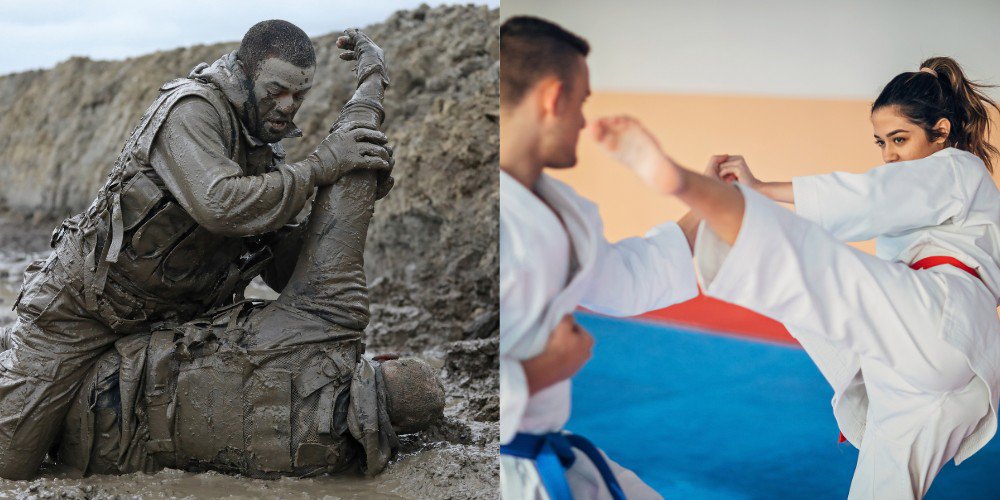
Comparing Karate and Krav Maga is a tall task because both are more umbrella terms than a singular style like boxing or wrestling. Karate has dozens of styles, some of which have little in common.
Things in Krav Maga are even more varied, as there are no competitions and big enough originations, and every “master” can open an academy and brand it with Krav Maga tags.
This means training methodologies and techniques can drastically differ in two schools, even if both presumably teach Krav Maga.
But when comparing the two, I will stick to the main styles and principles of the two systems and outline the good and bad practices I have encountered.
Key Features of Krav Maga
- Entirely made for self-defense with no sports element
- It aims to subdue the opponent as quickly as possible
- It has a wide variety of techniques, including striking, grappling, and weapons defense
- Krav Maga is principle-based and aims to provide maximum effectiveness
Key Features Of Karate
- Karate is trained both as a sport and for self-defense
- Most styles use only striking techniques like punching, kicking, knees, and elbows
- Karate is a system for full character development aiming to develop the body, mind, and spirit
- Karate has a strong sports element, and competitions are an essential part of many styles
Techniques
In most styles, Karate involves predominantly striking, which is what it’s known for. Strikes include punches, kicks, knees, elbows, and many open-hand strikes with various parts of the hand.
Karate kicks have a distinct technique that differs from popular styles like Muay Thai. In Karate, most kicks are thrown fast and snappy, landing with the foot. The kick itself should be like a whip and have no telegraph.
Some styles, like Shotokan, have limited grappling elements in the form of standing throws and sweeps, which are allowed in competition.
A few hybrid styles, like Kudo, include a serious grappling element and allow judo throws, takedowns, and ground fighting. Still, these styles are significantly less popular and widespread.
On the other hand, Krav Maga uses techniques from many different styles. Since the aim is to be efficient in different situations, everything that works can be a part of Krav Maga.
In addition to the striking and grappling techniques you may be familiar with from other martial arts, things like ground strikes, eye gouges, and similar things are also taught in Krav.
The other aspect of Krav Maga is weapons training, which usually includes defense and disarming against contemporary weapons like guns, knives, bats, etc.
Competitive Landscape
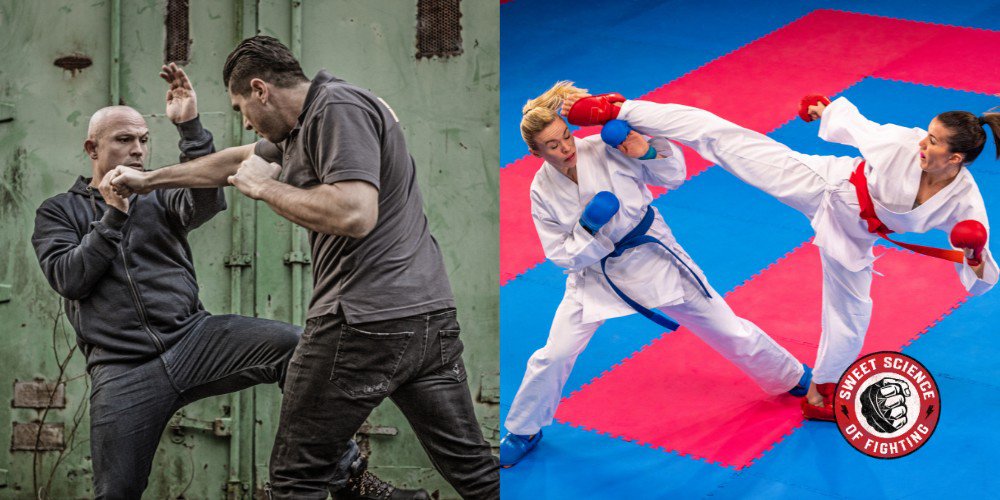
Early on, Karate was not a competition as Gichin Funakoshi frowned at the idea, but today, the most popular styles have extensive competition circuits.
Light contact styles are the most popular version, reaching the Olympic games in 2021. Full-contact karate styles like Kyokushin have many tournaments worldwide and thrive mainly because they have a solid sports element.
All karate styles have two types of competitions- kumite and kata. Kumite is the one-on-one contest you know from other combat sports, with the level of contact, legal strikes, and targets varying depending on the rules.
In kata, competitors perform a set sequence of techniques and are judged based on their execution.
Krav Maga has no competitions because it’s created to be used in real situations and has many inappropriate techniques for a sports contest.
Training
How martial arts are trained is more important than the techniques and principles they teach. In all karate styles, there are 3 types of training:
- Kihon (technique training- stances, strikes, blocks)
- Kata (performing a choreographed pattern of movements)
- Kumite (sparring)
Regardless of the type of sparring, the training elements in every style and dojo are always these three. Karate is very traditional and has strong ceremonial aspects.
Every school within the same style will teach the same katas and the same techniques, and each session begins and ends with a specific ritual.
On the other hand, Krav Maga training can be a thousand different things. Depending on the school and instructor, many drills can be used.
More often than not, training features drilling techniques in the air and then doing them on pads and heavy bags—something like MMA training but without the sparring.
Sparring may or may not be part of the curriculum. Weapons training always is, but in general, it’s impossible to detail how Krav Maga training is done, and the only way for you to know about your chosen school is to research that place specifically.
Equipment
You will need comfortable clothes for Krav Maga training, usually a T-shirt and joggers or pants. In terms of protective equipment, it depends on what kind of training the school does, but here is a complete list of things you likely need if you intend to spar:
- MMA gloves
- Boxing gloves
- Headgear
- Mouthguard
- Groin guard
- Muay Thai shin guards
Karate is done in a kimono/gi, which is mandatory for practice and competition, so this is the only uniform you will wear. Depending on the style you train in, the types of gloves and shin guards will differ but will always be required.
Krav Maga vs. Karate for MMA
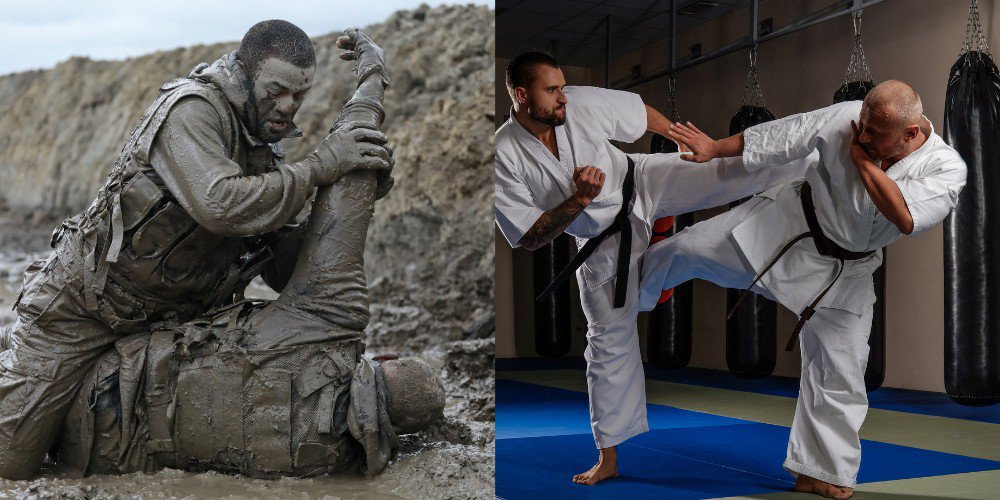
Karate is well-represented in MMA, which makes it the better style in this regard.
Karate may not be the most popular style used in MMA, but more than a few karatekas have successfully transitioned to the cage.
The ability to dart in and out with blinding speed, throw kicks from all angles, and do it without any wind-up works great in MMA with the right adjustments.
Fighters like Lyoto Machida, Stephen Thompson, and Kyoji Horiguchi have reached the top of the UFC by modifying their elite karate skills while still preserving the identity of the style.
Even fighters who have not trained in Karate, such as Connor McGregor and Henry Sejudo, have adopted many of its techniques and concepts.
Others, like George St. Pierre and Semmy Shilt, come from full-contact Karate backgrounds and have credited a solid portion of their success to their traditional base.
With that said, all sports versions of Karate (except Kudo) have strict rules and specific characteristics, which does not make them instantly usable in MMA.
Many modifications and additional skills must be learned before Karate can start working well in a cage fight.
Krav Maga does not fit well into a sporting contest with rules, but its aim and principles do not even attempt to do so in the first place, so effectiveness for MMA is not important for Krav Maga practitioners.
Krav Maga vs. Karate for Self-Defense
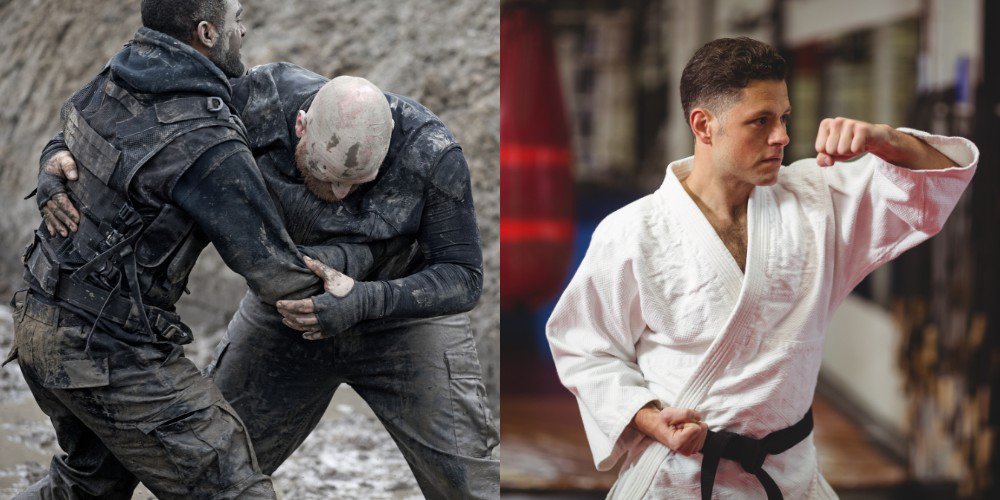
The most important comparison in the case of Karate and Krav Maga is their effectiveness for self-defense. Since this is the sole purpose of Krav, it should be the superior style, but this is not always the case.
Krav Maga suffers from a serious problem: the lack of any form of testing. Because it’s viewed as a set of principles with no set techniques, no competitions, and no single regulatory body, each school can teach whatever and however it wants to.
Sadly, this means most schools are McDojos, as is the popular term. This means you are taught some techniques with the promise of being super-efficient, but no one ever tests them; in reality, they are worthless.
Worse, some people develop a false sense of security by believing they can fight.
In this way, Krav Maga resembles Aikido and other similar styles, where every drill is done against a helpful and non-resisting partner, and this type of training will never enable you to fight against an aggressive opponent.
But good Krav Maga schools also exist. In them, a mix of proven striking and grappling techniques from things like boxing and BJJ are taught, but in a way more applicable in a street fight.
I have even seen videos of full-contact situations sparring with unexpected times of attack, against multiple attackers, within close confines, and many other realistic scenarios.
If you are lucky enough to find a school that emphasizes sparring, pressure testing, and simulating real-life situations, then it’s much better than Karate for self-defense, without any doubt.
Karate also has some serious flaws in terms of self-defense capabilities. Light contact styles teach you a very unrealistic way to fight by pulling your strikes back, which is the opposite of what you should do in a real fight.
Full-contact styles do not allow punching to the face, which is hardly a realistic feature. The lack of grappling in Karate also results in a serious gap for self-defense.
The truth about which is better for self-defense differs for every Krav Maga school and every karate style. If you train against resisting training partners, you can apply the skills in real life.
If not, it’s just a fitness class.
Which Is Better? Krav Maga or Karate?
Just like every other meaningful comparison between styles, the answer is personal. Both Karate and Krav Maga have flaws and strong sides, depending on what you are looking for.
If you want to learn how to defend yourself quickly, and that’s the entire extent of your martial arts goals, then Krav Maga is the better choice IF the school you have access to is good.
This means there has to be sparring, pressure testing, and realistic scenarios. If these things are not part of the curriculum, I believe training in Krav Maga is pointless, as it will not fulfill its only purpose—to teach you how to defend yourself.
Karate is not only a fighting style. In fact, many karate instructors would tell you fighting is not even the primary purpose. Karate is an art that aims to improve your body, mind, and spirit. It’s a way of character development and instilling virtues through martial arts skills.
If this is your thing and you enjoy rigid traditions and rituals while also acquiring some degree of realistic fighting skills, then you won’t find a better thing in the world.
But if your main goal is to learn how to fight more realistically and not care as much for the spiritual side, most other combat sports like Muay Thai, boxing, MMA, or BJJ will be better for you.

